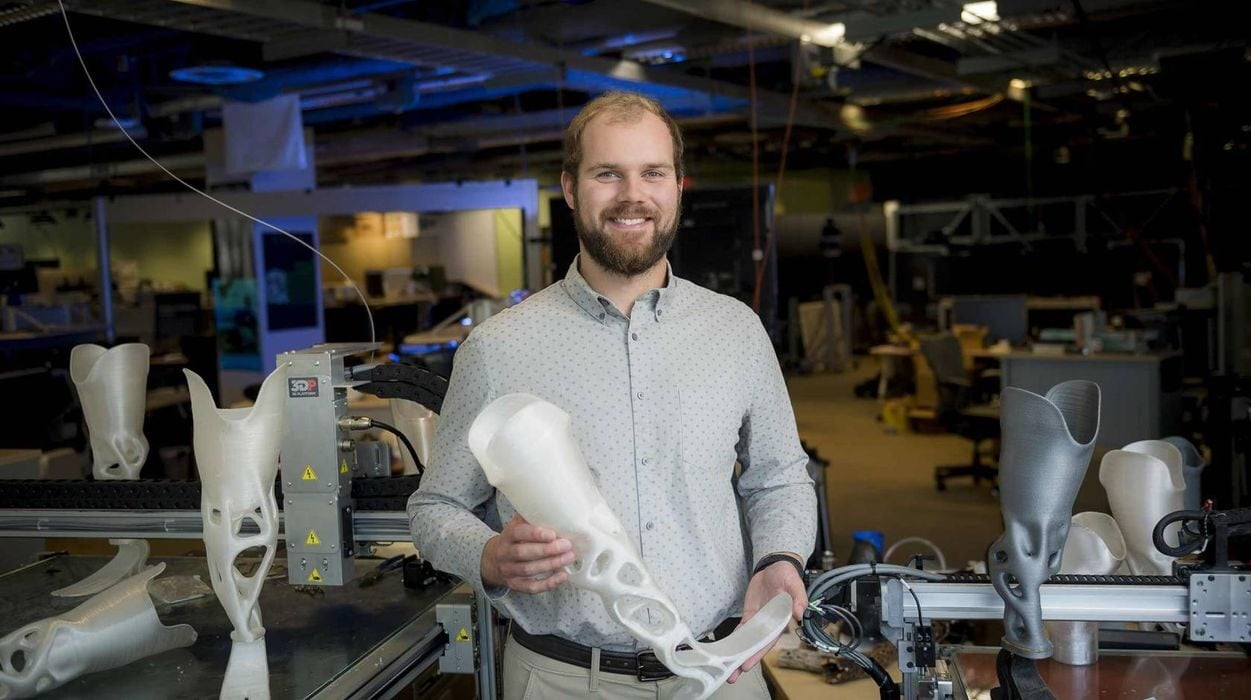
Charles R. Goulding and Preeti Sulibhavi reveal how combining bio-inspired engineering with cutting-edge 3D printing, Limber Prosthetic has developed a lightweight, customizable below-the-knee prosthetic that is redefining mobility and accessibility for amputees worldwide.
Advancements in 3D printing have revolutionized many industries, from aerospace to healthcare. One of the most inspiring applications of this technology is in the field of prosthetics. Limber Prosthetic (Limber), a University of California, San Diego (UC San Diego) student spin-out, has pioneered a groundbreaking 3D printed below-the-knee prosthetic. With a multidisciplinary founding team and an innovative bio-inspired design, Limber is set to redefine mobility for amputees worldwide.
A Synergistic Team Driving Innovation
Limber’s founding team brings together complementary expertise to tackle the challenges of prosthetic development. Joshua Pelz, a materials expert and engineer, has spearheaded extensive materials experimentation to optimize the prosthetic’s composition. His co-founder, Luca Da Vivo Nicoloso, serves as COO and has leveraged his engineering expertise in product design and manufacturing. The third co-founder, Herb Barrak, is a seasoned prosthetic expert who ensures clinical viability and market accessibility.
Achieving a proper fit for below-the-knee prosthetics has historically been an arduous and time-consuming process for amputees. Pelz and his team have addressed this challenge by developing a lightweight, 3D printed prosthetic that enhances comfort and functionality. Early in their research, they assumed that a prosthetic should match the weight of a lost limb. However, user feedback and testing revealed that a lighter prosthetic offers superior adaptability and ease of movement. By incorporating advanced materials and innovative structural design, Limber has created a prosthetic that improves the overall experience for amputees.

Bio-Inspired Engineering: Learning from Nature
One of the most remarkable aspects of Limber’s approach is its bio-inspired design, drawing insights from the desert Cholla Cactus. Unlike traditional bio-mimicry, which seeks to replicate natural structures, bio-inspiration involves learning from nature’s engineering principles to develop innovative solutions. The Cholla Cactus has an intricate, lightweight inner skeleton that allows it to withstand strong desert winds. Luca Da Vivo Nicoloso, a co-author of a technical paper on the biomechanical properties of the Cholla Cactus, has incorporated these principles into Limber’s prosthetic design.
By leveraging the structural efficiency of the Cholla Cactus, Limber has developed a prosthetic with superior torsional flexibility and durability. This bio-inspired architecture enhances shock absorption and load distribution, crucial factors in ensuring long-term comfort and performance for amputees. The integration of bio-inspired functionality into 3D printed prosthetics represents a paradigm shift in how medical devices are designed and manufactured.
The Role of 3D Printing in Prosthetic Development
Traditional prosthetic manufacturing is often expensive and time-consuming, requiring custom molds, manual labor, and multiple fittings. 3D printing streamlines this process by enabling rapid prototyping, precise customization, and cost-efficient production.
Customization and Fit Optimization
One of the key benefits of 3D printing in prosthetics is the ability to create patient-specific designs. Each limb loss case is unique, requiring a customized approach for optimal comfort and mobility. Limber employs digital scanning technology to capture precise limb geometries, ensuring a tailored fit for each patient. This data-driven approach minimizes the need for manual adjustments and shortens the time between assessment and prosthetic delivery.
Material Science and Structural Efficiency
Limber has dedicated extensive research to selecting optimal materials for 3D printing prosthetics. By experimenting with various composites and polymers, the team has developed a lightweight yet durable prosthetic that can withstand daily wear and tear. The material composition mimics the mechanical properties of human bone, providing the necessary strength and flexibility while reducing fatigue-related stress on the user.
Accelerated Production and Cost Reduction
The conventional prosthetic manufacturing process can take weeks or even months to complete. Limber’s 3D printing approach dramatically reduces this timeline, enabling the production of a fully functional below-the-knee prosthetic in just 12 hours. This rapid turnaround time is particularly beneficial for individuals in underserved communities, where access to prosthetic care is often limited.
Additionally, 3D printing significantly lowers production costs compared to traditional manufacturing methods. By eliminating the need for expensive molds and manual labor, Limber can offer high-quality prosthetics at a fraction of the typical price. This affordability makes advanced prosthetic solutions accessible to a broader population, improving quality of life for many amputees.

Enhancing Global Accessibility with Technology
Limber’s commitment to social impact is evident in its philanthropic efforts. Once a quarter, the founders travel to Mexico to provide prosthetic solutions to economically disadvantaged amputees, free of charge. This initiative not only empowers individuals in need but also allows the Limber team to gather valuable clinical insights for continuous product improvement.
A crucial aspect of this outreach program is the use of smartphones to facilitate remote prosthetic fittings. By transmitting images and patient data via mobile devices, Limber can create precise 3D printed prosthetics without requiring in-person visits. This innovative approach bridges the gap between medical expertise and remote patient care, demonstrating the potential of technology to transform global healthcare accessibility.
The Future of 3D Printed Prosthetics
Limber Prosthetic exemplifies the immense potential of 3D printing in healthcare. By integrating engineering, biology, and digital innovation, the company has developed a solution that is not only functional but also cost-effective and widely accessible. As 3D printing technology continues to advance, the future of prosthetics will likely see further improvements in material science, structural optimization, and manufacturing efficiency.
With continued research and development, we may witness the emergence of prosthetics that incorporate smart sensors, adaptive materials, and even AI-driven customization. These advancements will enhance the user experience, providing greater mobility, comfort, and independence for amputees worldwide.
The Research & Development Tax Credit
The now permanent Research and Development (R&D) Tax Credit is available for companies developing new or improved products, processes and/or software.
3D printing can help boost a company’s R&D Tax Credits. Wages for technical employees creating, testing and revising 3D printed prototypes are typically eligible expenses toward the R&D Tax Credit. Similarly, when used as a method of improving a process, time spent integrating 3D printing hardware and software can also be an eligible R&D expense. Lastly, when used for modeling and preproduction, the costs of filaments consumed during the development process may also be recovered.
Whether it is used for creating and testing prototypes or for final production, 3D printing is a great indicator that R&D Credit-eligible activities are taking place. Companies implementing this technology at any point should consider taking advantage of R&D Tax Credits.
Conclusion
Limber Prosthetics’ pioneering work showcases the transformative impact of 3D printing on medical devices. Their bio-inspired, lightweight, and customizable below-the-knee prosthetic is a testament to the power of interdisciplinary collaboration. By combining engineering ingenuity with a deep understanding of natural biomechanics, Limber has created a prosthetic solution that not only improves lives but also sets a new standard for the industry.
Moreover, their commitment to social responsibility underscores the profound role that innovation can play in humanitarian efforts. Through the fusion of technology, accessibility, and perseverance, Limber Prosthetic is leading the way in redefining mobility solutions for amputees worldwide. Their journey serves as an inspiring example of how 3D printing can be harnessed to address pressing medical challenges and enhance the human condition.
